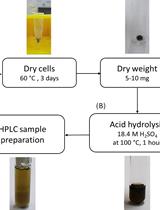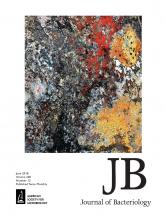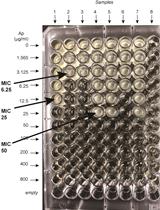- EN - English
- CN - 中文
Extraction and Analysis of Bacterial Teichoic Acids
细菌磷壁酸的提取与分析
发布: 2018年11月05日第8卷第21期 DOI: 10.21769/BioProtoc.3078 浏览次数: 11735
评审: Andrea PuharTimo A LehtiAksiniya Asenova

相关实验方案

酸水解-高效液相色谱法测定集胞藻PCC 6803中聚3-羟基丁酸酯的含量
Janine Kaewbai-ngam [...] Tanakarn Monshupanee
2023年08月20日 1736 阅读

基于高效液相色谱法的史氏分枝杆菌DisA环二腺苷酸(C-di-AMP)合成酶活性研究
Avisek Mahapa [...] Dipankar Chatterji
2024年12月20日 1700 阅读
Abstract
Teichoic acids (TA) are anionic polymers comprised of polyol phosphate repeat units that are abundant in the cell wall of Gram-positive bacteria. Both wall teichoic acid (WTA) and lipoteichoic acid (LTA) play important roles in regulating cell wall remodeling as well as conferring antibiotic resistance. To analyze TA, we describe a polyacrylamide gel electrophoresis (PAGE) method for both WTA and LTA. To extract crude WTA, the peptidoglycan sacculus is first isolated and WTA is then liberated by hydrolysis. LTA is extracted by 1-butanol and pre-treated with lipase to prevent aggregation and improve single-band resolution by PAGE. Crude extracts of both TAs are then subjected to PAGE followed by Alcian blue and silver staining. These protocols are easily adoptable by laboratories interested in rapidly analyzing TAs and can be used determine the relative abundance, relative polymer length and whether TAs are glycosylated. More detailed TA structural and compositional information can be obtained using the described purification protocols by nuclear magnetic resonance (NMR) and electrospray ionization mass spectrometry (ESI-MS) analysis.
Keywords: Wall teichoic acid (壁磷壁酸)Background
The hallmark of Gram-positive bacteria is a thick cell wall comprised of a peptidoglycan matrix embedded with anionic polyol phosphate polymers collectively called teichoic acids (TA) (Weidenmaier and Peschel, 2008; Silhavy et al., 2010; Brown et al., 2013; Percy and Gründling, 2014). Many Gram-positive bacteria have both wall teichoic acid (WTA) and lipoteichoic acid (LTA) whereby WTA is covalently linked to the peptidoglycan layer and LTA is anchored to the cell membrane via a diacylglycerol moiety. TAs regulate numerous cell envelope-associated processes, including autolysin activity and confer resistance to antibiotics such as daptomycin and β-lactams (Winstel et al., 2014). TA function can be further modulated by a variety of side chain modifications, including D-alanylation (D-ala) and glycosylation (Kovács et al., 2006; Mechler et al., 2016; Rismondo et al., 2018). In Staphylococcus aureus, WTA is comprised of poly-ribitol phosphate repeats whereas its LTA contains polyglycerol phosphate repeats (Swoboda et al., 2010; Percy and Gründling, 2014; Kho and Meredith, 2018). Both polymers are modified with D-ala and α/β-GlcNAc residues, in a manner that can vary between S. aureus strains and environmental culture conditions (Percy and Gründling, 2014; Kho and Meredith, 2018). Methods to rapidly monitor changes in TA structure and identify modifications are thus useful in understanding cell envelope physiology.
Although the S. aureus TA polymer backbones are structurally similar and common methods can be used to analyze their composition, WTA and LTA isolation requires specific extraction methods and care must be taken to prevent cross contamination between polymers. WTA is isolated from the crude peptidoglycan sacculus after thorough washing with detergent to remove LTA. Hydrolysis with either sodium hydroxide or trichloroacetic acid is then used to liberate water soluble WTA from peptidoglycan (Meredith et al., 2008). It is often advisable to extract parallel WTA samples using both methods, as acid/base labile side chain modifications may be inadvertently cleaved during isolation and subsequently overlooked. For instance, D-ala esters are readily cleaved under moderately basic conditions (Morath et al., 2001). To obtain membrane-bound LTA, cells are counter extracted with 1-butanol to disrupt the phospholipid bilayer (Morath et al., 2001; Draing et al., 2006; Gründling and Schneewind, 2007). WTA remains insoluble in the cell remnant pellet, while more hydrophobic phospholipids partition into the organic phase. Once clarified, the aqueous phase is
Either crude WTA or LTA extract can then be initially analyzed by PAGE (Wolters et al., 1990; Pollack and Neuhaus, 1994). While WTA can be loaded directly, LTA PAGE resolution benefits from pretreatment with lipases to deacylate the diacylglycerol anchor (Kho and Meredith, 2018). The distinctive “laddering” of bands in TA-PAGE results from TA chain lengths whereby each subsequent band represents a polymer chain length of n + 1 (Figure 1). The relative abundance and polymer length profile can be evaluated, as well as the presence of heterogeneous side chain modifications which induce an ill-defined smear upon TA visualization. TA can be visualized by immunoblotting with α-TA antibodies (Wörmann et al., 2011), or directly imaged using the cationic dye Alcian blue coupled with modified silver staining for enhanced sensitivity (Meredith et al., 2008; Kho and Meredith, 2018).
To elucidate the TA structure, composition and degree of modifications, extraction protocols can be scaled up and nuclear magnetic resonance (NMR) and electrospray ionization mass spectrometry (ESI-MS) used for subsequent characterization (Bernal et al., 2009; Eugster and Loessner, 2011; Shen et al., 2017). Although purity is often adequate for NMR analysis of hydrolyzed WTA at this stage (Figure 3), hydrophobic interaction chromatography is used for further purification of LTA (Morath et al., 2001). Anion exchange chromatography is a convenient method for further purification of either polymer (Fischer et al., 1993; Kim et al., 2005; Eugster and Loessner, 2011). Purified and intact LTA can be analyzed directly by NMR (Figure 3) but ESI-MS analysis of TA monomers is a particularly sensitive approach for detection of low abundance modifications. Hydrofluoric acid (HF)-catalyzed TA depolymerization through dephosphorylation has been developed for WTA (Eugster and Loessner, 2011; Shen et al., 2017), but can also be utilized to analyze LTA (Figure 4; Kho and Meredith, 2018).
Although the methods described here are routinely used to analyze the TA of Staphylococcus aureus, it should be noted they are most suitable for TA chemotypes harboring phosphodiester repeating units. In contrast, the cell wall polymers of some Gram-positive bacteria such as Streptococcus pyogenes (Group A Streptococcus) are comprised of rhamnose repeating units (Mistou et al., 2016), and may lack the polyanionic charge necessary for certain methods such as TA-PAGE.
Protocols:
Part I:Extraction and analysis of teichoic acids by PAGE
- Crude wall teichoic acid (WTA) extraction for PAGE
- Crude lipoteichoic acid (LTA) extraction for PAGE
- Teichoic acid PAGE and staining
- Polyacrylamide gel electrophoresis (PAGE)
- Alcian blue–silver staining
Part II:Extraction and analysis of teichoic acids by1H NMR and ESI-MS
- Wall teichoic acid (WTA) precipitation for nuclear magnetic resonance
- Lipoteichoic acid (LTA) purification by hydrophobic interaction chromatography
- Extraction of crude LTA
- Hydrophobic interaction chromatography
- Phosphate content analysis of LTA fractions
- 1H NMR and ESI-MS analysis of teichoic acids
- 1H Nuclear magnetic resonance
- Dephosphorylation and monomerization of LTA for ESI-MS
- Electrospray ionization mass spectrometry (ESI-MS)
Part I: Extraction and analysis of teichoic acids by PAGE
Materials and Reagents
Crude wall teichoic acid (WTA) extraction for PAGE
- Pipette tips
- 50 ml centrifuge tubes (Fisher Scientific, catalog number: 14-955-240)
- Inoculation loops (VWR, catalog number: 12000-810)
- 2 ml microcentrifuge tubes (VWR, catalog number: 87003-298)
- 1.7 ml microcentrifuge tubes (VWR, catalog number: 87003-294)
- Staphylococcus aureus or other Gram-positive bacteria (Approximately 100 μl of wet cell pellet)
- MilliQ dH2O
- Tryptic soy broth (TSB) (BD, catalog number: 211822)
- 2-(N-morpholino)ethanesulfonic acid (MES) (Fisher Bioreagents, catalog number: BP300-100)
- Sodium dodecyl sulfate (SDS) (BP, catalog number: 166-500)
- Sodium chloride (NaCl) (Sigma, catalog number: S5886)
- Tris (Fisher Bioreagents, catalog number: BP152-5)
- Proteinase K (Amresco, catalog number: 0706-100mg)
- Sodium hydroxide (NaOH) (EMD Millipore, catalog number: 1064621000)
- Hydrochloric acid (HCl) (Sigma, catalog number: 258148-500ML)
- Trichloroacetic acid (TCA) (BDH, catalog number: BDH9310-500G)
- Buffer 1 (50 mM MES, pH 6.5) (see Recipes)
- Buffer 2 (4% [wt/vol] SDS, 50 mM MES, pH 6.5) (see Recipes)
- Buffer 3 (2% NaCl, 50 mM MES, pH 6.5) (see Recipes)
- Digestion buffer (20 mM Tris-HCl pH 8.0, 0.5% [w/v] SDS) (see Recipes)
- Proteinase K solution (2 mg/ml) (see Recipes)
Crude lipoteichoic acid (LTA) extraction for PAGE
- Pipette tips
- 50 ml centrifuge tubes (Fisher Scientific, catalog number: 14-955-240)
- Inoculation loops (VWR, catalog number: 12000-810)
- 2 ml microcentrifuge tubes (VWR, catalog number: 87003-298)
- 1.7 ml microcentrifuge tubes (VWR, catalog number: 87003-294)
- PCR tubes (VWR, catalog number: 20170-004)
- pH strips (EMD Millipore, catalog number: 700181-2)
- Staphylococcus aureus or other Gram-positive bacteria (Approximately 100 μl of wet cell pellet)
- MilliQ dH2O
- Tryptic soy broth (TSB) (BD, catalog number: 211822)
- Citric acid monohydrate (Sigma-Aldrich, catalog number: C7129)
- Sodium hydroxide (NaOH) (EMD Millipore, catalog number: 1064621000)
- Zirconia/silica beads (0.1 mm; Biospec Products, catalog number: 11079101z)
- 1-butanol (Thermo Scientific, catalog number: A399)
- Tris (Fisher Bioreagents, catalog number: BP152-5)
- Resinase HT (Strem Chemicals, catalog number: 06-3125)
- 20x Citrate buffer (see Recipes)
- Resuspension buffer (see Recipes)
Teichoic acid PAGE and staining
- Pipette tips
- Gel loading tips (VWR, catalog number: 53509-015)
- 50 ml centrifuge tubes (Fisher Scientific, catalog number: 14-955-240)
- 14 ml tubes (Corning, catalog number: 352057)
- Large glass dish for staining (Pyrex, catalog number: 1085782)
- MilliQ dH2O
- Tris (Fisher Bioreagents, catalog number: BP152-5)
- Hydrochloric acid (HCl) (Sigma, catalog number: 258148-500ML)
- 40% acrylamide solution (Fisher Bioreagents, catalog number: BP1402-1)
- Bis-acrylamide (EMD Millipore, catalog number: 8059680250)
- Tricine (Fisher Bioreagents, catalog number: BP315-100)
- TEMED (Fisher BioReagents, catalog number: BP150-20)
- Ammonium persulfate (APS) (Fisher BioReagents, catalog number: BP179-25)
- 70% ethanol (Fisher BioReagents, catalog number: BP8201500)
- Glycerol (Fisher Bioreagents, catalog number: BP229-4)
- Bromophenol blue (Sigma, catalog number: 114391-5G)
- Alcian blue 8GX (Alfa Aesar, catalog number: J60122)
- Glacial acetic acid (EMD, catalog number: AX0073-9)
- Potassium dichromate (JT Baker, catalog number: 3090-01)
- Nitric acid (Amresco, catalog number: 0697-100ML)
- Silver nitrate (Fisher Bioreagents, catalog number: BP2546-100)
- Sodium carbonate (VWR, catalog number: 0585-500G)
- Formaldehyde, 37% (Sigma, catalog number: F1635-500ml)
- Gel buffer (see Recipes)
- 10% ammonium persulfate (APS) (see Recipes)
- 10x Tris-Tricine buffer (see Recipes)
- Running buffer (see Recipes)
- Resolving acrylamide solution (30% T, 6% C) (see Recipes)
- Stacking acrylamide solution (30% T, 2.6% C) (see Recipes)
- 4x loading dye (see Recipes)
- Alcian blue solution (1 mg/ml, 3% acetic acid) (see Recipes)
- Oxidizing solution (see Recipes)
- Silver nitrate solution (see Recipes)
- Developer (see Recipes)
- Acetic acid, 0.1 M (see recipes)
Equipment
Crude wall teichoic acid (WTA) extraction for PAGE
- Shaking incubator (Thermo Scientific, catalog number: SHKE6000)
- Table-top centrifuge (Eppendorf, catalog number: 022621807)
- Micropipettes
- Hot plate (VWR, catalog number: 97042-698)
- Beaker
- Thermomixer (Eppendorf, catalog number: 022670107)
- Shaking incubator (Thermo Scientific, catalog number: SHKE6000)
- Centrifuge (Eppendorf, catalog number 022623508)
- Rotor (Eppendorf, catalog number: 022638009)
- Table-top centrifuge (Eppendorf, catalog number: 022621807)
- Micropipettes
- MagNA Lyser (Roche, catalog number: 03358968001)
- Thermomixer (Eppendorf, catalog number: 022670107)
- Thermocycler (Bio-Rad, catalog number: 1861096)
Teichoic acid PAGE and staining
- PROTEAN® II xi 2-D Tube Gel Cell (Bio-Rad, catalog number: 1651931)
- Beakers
- Stir plate (VWR, catalog number: 97042-590)
- Stir bars
- Pipette controller (BrandTech Scientific, catalog number: 26330)
- Micropipettes
- Shaker (Alkali Scientific, catalog number: RS7061)
Procedure
文章信息
版权信息
© 2018 The Authors; exclusive licensee Bio-protocol LLC.
如何引用
Kho, K. and Meredith, T. C. (2018). Extraction and Analysis of Bacterial Teichoic Acids. Bio-protocol 8(21): e3078. DOI: 10.21769/BioProtoc.3078.
分类
微生物学 > 微生物生理学 > 细胞壁
微生物学 > 微生物生物化学 > 其它化合物
生物化学 > 其它化合物 > 磷壁酸
您对这篇实验方法有问题吗?
在此处发布您的问题,我们将邀请本文作者来回答。同时,我们会将您的问题发布到Bio-protocol Exchange,以便寻求社区成员的帮助。
Share
Bluesky
X
Copy link










